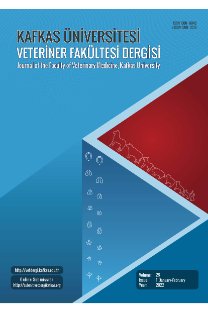Sequencing and Phylogenetic Analysis Reveal the Prevalence of Duck Hepatitis A Virus Genotype-3 in Vietnam
Sekans ve Filogenetik Analiz Vietnamda Ördek Hepatitis A Virüs Genotip-3'ün Prevalansını Ortaya Koymaktadır
___
- Levine P, Fabricant J: A hitherto-undescribed virus disease of ducks in North America. Cornell Vet, 40, 71-86, 1950.
- Woolcock PR: Duck hepatitis. In, Saif YM, Barnes HJ, Glisson JR, Fadly AM, McDougald LR, Swayne DE (Eds): Diseases of Poultry. 11th edn., 343- , Iowa State University Press, Ames, 2003.
- Haider SA, Calnek BW: In vitro isolation, propagation, and characterization of duck hepatitis virus typee III. Avian Dis, 23, 715-729, DOI: 10.2307/1589748
- Toth TE: Studies of an agent causing mortality among ducklings immune to duck virus hepatitis. Avian Dis, 13, 834-846, 1969. DOI: 2307/1588590
- Knowles NJ, Hovi T, Hyypia T, King AMQ, Lindberg AM, Pallansch MA, Palmenberg AC, Simmonds P, Skern T, Stanway G, Yamashita T, Zell R: Picornaviridae. In, King AMQ, Adams MJ, Carstens EB, Lefkowitz EJ (Eds): Virus taxonomy: Classification and nomenclature of viruses: ninth report of the International Committee on Taxonomy of Viruses. 855-880, Elsevier, San Diego, California, 2012.
- Kim MC, Kwon YK, Joh SJ, Lindberg AM, Kwon JH, Kim JH: Molecular analysis of duck hepatitis virus type 1 reveals a novel lineage close to the genus Parechovirus in the family Picornaviridae. J Gen Virol, 87, 3307- , 2006. DOI: 10.1099/vir.0.81804-0
- Ding C, Zhang D: Molecular analysis of duck hepatitis virus type 1. Virology, 361, 9-17, 2007. DOI: 10.1016/j.virol.2007.01.007
- Tseng CH, Tsai HJ: Molecular characterization of a new serotype of duck hepatitis virus. Virus Res, 126, 19-31, 2007. DOI: 10.1016/j.virusres. 01.012
- Fu Y, Pan M, Wang X, Xu Y, Yang H, Zhang D: Molecular detection and typing of duck hepatitis A virus directly from clinical specimens. Vet Microbiol, 131, 247-257, 2008. DOI: 10.1016/j.vetmic.2008.03.011
- Jin X, Zhang W, Zhang W, Gu C, Cheng G, Hu X: Identification and molecular analysis of the highly pathogenic duck hepatitis virus type 1 in Hubei province of China. Res Vet Sci, 85, 595-598, 2008. DOI: 10.1016/j. rvsc.2008.01.001
- Gao J, Chen J, Si X, Xie Z, Zhu Y, Zhang X, Wang SJ, Jiang S: Genetic variation of the VP1 gene of the virulent duck hepatitis A virus type 1 (DHAV-1) isolates in Shandong province of China. Virol Sin, 27, 248-253, DOI: 10.1007/s12250-012-3255-8
- Xu Q, Zhang RH, Chen LL, Yang L, Li JX, Dou PF, Wang H, Xie ZH, Wang Y, Jiang SJ: Complete genome sequence of a duck hepatitis A virus type 3 identified in Eastern China. J Virol, 86, 13848, 2012. DOI: 10.1128/ JVI.02651-12
- Chen LL, Xu Q, Zhang RH, Yang L, Li JX, Xie ZJ, Zhu YL, Jiang SJ, Si XK: Improved duplex RT-PCR assay for differential diagnosis of mixed infection of duck hepatitis A virus type 1 and type 3 in ducklings. J Virol Methods, 192, 12-17, 2013. DOI: 10.1016/j.jviromet.2013.04.012
- Lin SL, Cong RC, Zhang RH, Chen JH, Xia LL, Xie ZJ, Wang Y, Zhu YL, Jiang SJ: Circulation and in vivo distribution of duck hepatitis A virus types 1 and 3 in infected ducklings. Arch Virol, 161, 405-416, 2016. DOI: 1007/s00705-015-2648-z
- Wei CY, Su S, Huang Z, Zhu WJ, Chen JD, Zhao FR, Wang YJ, Xie JX, Wang H, Zhang G: Complete genome sequence of a novel duck hepatitis A virus discovered in Southern China. J Virol, 86, 10247, 2012. DOI: 1128/JVI.01643-12
- Doan HTT, Le XTK, Do RT, Hoang CTM, Nguyen KT, Le TH: Molecular genotyping of duck hepatitis A viruses (DHAV) in Vietnam. J Infect Dev Ctries, 10, 988-995, 2016. DOI: 10.3855/jidc.7239
- Tamura K, Stecher G, Peterson D, Filipski A, Kumar S: MEGA 6: Molecular evolutionary genetics analysis version 6.0. Mol Biol Evol, 30, 2729, 2013. DOI: 10.1093/molbev/mst197
- Kim MC, Kwon YK, Joh SJ, Kim SJ, Tolf C, Kim JH: Recent Korean isolates of duckhepatitis virus reveal the presence of a new geno- and serotype when compared to duck hepatitis virus type 1 type strains. Arch Virol, 152, 2059-2072, 2007. DOI: 10.1007/s00705-007-1023-0
- Wang L, Pan M, Fu Y, Zhang D: ClassiŞcation of duck hepatitis virus into three genotypes based on molecular evolutionary analysis. Virus Genes, 37, 52-59, 2008. DOI: 10.1007/s11262-008-0233-1
- Li J, Bi Y, Chen C, Yang L, Ding C, Liu W: Genetic characterization of duck hepatitis A viruses isolated in China. Virus Res, 178, 211-216, 2013. DOI: 10.1016/j.virusres.2013.10.007
- ISSN: 1300-6045
- Yayın Aralığı: 6
- Başlangıç: 1995
- Yayıncı: Kafkas Üniv. Veteriner Fak.
MEHMET ŞAHAL, ABDÜLKERİM DENİZ, Rıfat VURAL, ŞÜKRÜ KÜPLÜLÜ, İBRAHİM MERT POLAT, EKREM ÇAĞATAY ÇOLAKOĞLU, NACİ ÖCAL, Hasan Ceyhun MACUN, MERT PEKCAN, Marion OCAK
Xiancheng ZENG, Qingli ZHENG, Xuelin CHI
AYŞE MENTEŞ GÜRLER, ALİ YİĞİT, ŞULE SANAL
Biomechanical Parameters of Asian Elephant (Elephas maximus)Walking Gait
Siriphan KONGSAWASDI, Sittidej MAHASAWANGKUL, Pornsawan PONGSOPAWIJIT, Kajornphat BOONPRASERT, Busaba CHUATRAKOON, Nipaporn THONGLORM, Rungtiwa KANTA-IN, Tanapong TAJARERNMUANG, Korakot NGANVONGPANIT
Hacı Ahmet DEVECİ, ABDULSAMED KÜKÜRT, ERDOĞAN UZLU, İBRAHİM SÖZDUTMAZ, OĞUZ MERHAN, MUSTAFA SİNAN AKTAŞ, MERVE ALPAY, İNAN KAYA, MAHMUT KARAPEHLİVAN
Asghar GHAHREMANI, Ali Asghar SADEGHI, Saeed HESARAKI, Mohammad CHAMANI, Parvin SHAWRANG
Corneal Impression Cytology for the Diagnosis of Limbal Stem Cell Deficiency in a Dog
F. Eser ÖZGENCİL, Nurhayat GÜLMEZ, Çağrı GÜLTEKİN, Serkan SAYINER
Zhitao WANG, Jungang WANG, Yongsheng ZHANG, Xudong WANG, Xiaoli ZHANG, Yu LIU, Jifeng XI, Hao TONG, Qiaoli WANG, Bin JIA, Hong SHEN
Wenyan GAI, Junwei WANG, Juan WANG, Zhigang CUI, Zhina QU, Yundong WANG, Jun HONG, Jinghua CUI, Shigan YAN, Xiaoli DU, Xiumei HUANG, Jianmei ZHAO, Liping ZHU
RECEP GÜMÜŞ, H. Serkan EROL, HALİT İMİK, MESUT BÜNYAMİ HALICI
